Features, Mechanisms and Optimization of Embodied Carbon Emissions for Energy Supply Bases: Case Study of Shanxi, China
Abstract
:1. Introduction
2. Materials and Methods
2.1. Case Study
2.2. Methodology
2.2.1. ECEs-PT Spatio-Temporal Evolution: EEBT Model
2.2.2. Driving Mechanisms and Deep-Seated Causes Analysis Based on Two-Stage SDA Model
2.2.3. Optimization Policies Equationtion: CR Model
2.3. Data
3. Results
3.1. The Variation Features of the ECEs-PT Outflow in Shanxi
3.2. Spatio-Temporal Features of the Net ECEs-PT Outflow in Shanxi
3.3. Industry Features of the Net ECEs-PT Outflow in Shanxi
3.4. Driving Mechanisms and Deep-Seated Causes of the Net ECEs-PT Transference in Shanxi
4. Discussion
4.1. Coupling Relation between Net CV Outflow Effect and Net ECEs-PT Outflow Effect
4.1.1. Industrial Classification
4.1.2. Optimization for Each Types
4.2. Deep Optimization for the Case Industries
4.2.1. Optimization for Coalmin
4.2.2. Optimization for MetalSmelt
4.2.3. Optimization for RefPetral
5. Conclusions
- (a)
- This study revealed the spatio-temporal features of the net ECEs-PT outflow. From 1997 to 2012, the net ECEs-PT outflows in Shanxi continuously grew, the spatial trend is “from expanded coverage to agglomeration enhancement”. and the target provinces of the ECEs-PT agglomerated to the eastern coastal provinces. This reflected the typical features of ESBs with the continuous expansion of energy demand and the increasingly detailed division of labor. (1) Energy trade grows rapidly, the target provinces of energy outflow gradually concentrate to some major trading regions; (2) ESBs gradually depend highly on the trade of direct energy products, which leads to a single industrial structure. Industries with potential for high technology and high investment are confronted with recession risk, dilemma of the “resource curse”, and difficulty in economic transformation; (3) while interregional energy trade gains short-term economic benefits rapidly and supports energy demand in other regions, it brings an enormous amount of ECEs-PT transference and other negative environmental effects, which result in great ecological pressures; (4) in the process of achieving the urgent CER goals, ESBs need to meet energy needs and secure energy supplies, which bring great pressure to ESBs.
- (b)
- This study explored the driving mechanisms of ECEs-PT transference. By using the two-stage SDA, we analyzed deep-seated causes of ECEs-PT transference of the 28 sectors in ESBs. The results showed that (1) low technology level and high trade demand were the dual driving forces that lead to changes in the patterns of ECEs-PT transference in ESBs. Trade demand stimulates changes in ECEs-PT transference through changes in trade scales and trade structures; (2) the rapid increase in trade demand stimulates the industrial structure of ESBs highly concentrated in the production of energy products, thus supporting the demand for energy and obtaining rapid economic benefits, which hinders the improvement of the overall technology level of the industry; (3) the concentrations of trade structures and differences in technology level cause ESBs to be the low-end production link of the energy industry value chain over the long-term and to further rely on the energy trade; (4) for industries with different technology and trade structure characteristics, the trade scale plays a different role in the growth of carbon emissions transference.
- (c)
- According to the CR model, we analyzed the elasticity between the trade values and carbon emission transferences of different industries. By combining the driving force analysis conclusions, we proposed targeted optimization and control strategies for ESBs. (1) We divided the sectors into four types: Type A is the promoted type, and the optimization measure is increase investment, scale up production, and increase market share; Type B is the controlled type, and the optimization measure is reducing investment, controlling production scale, and reducing market share; Type C is the adjusted type, and the optimization measure for Type C1 is moderately increasing investment, expanding interprovincial trade with those lower industrial advantages provinces; the optimization measure for Type C2 is expanding interprovincial trade with those lower industrial advantages provinces and reducing interprovincial trade with those greater industrial advantages provinces; Type D is the regulated type, and the optimization measure is reducing investment, controlling production scale, and combining market regulation and government control; (2) this study proposes a regulation sequence of first optimizing and then controlling industries in Shanxi to improve the technical level of ESBs, expanding and improving industrial systems, gradually guiding the exit of energy-dependent industries, and finally changing the industrial development mode of extensive technology and the unitary structure of ESBs. This sequence will eventually achieve the best CER effect at a lower economic cost and achieve a great degree of CER effects on the basis of less interference to the stability of energy supply, and achieve sustainable CER goals.
- (d)
- This study discussed the optimization strategies for the trade structures of the top three net ECEs-PT outflow sectors. By gradually adjusting the trade structures of high-concentration industries, the relevance of CER measures for different industries in different provinces can be enhanced. By targeting different industries, we divided the provinces into expanding trade scales and reducing trade scales to rectify “campaign-style carbon reduction” that cause excessive emission reduction and threaten the security and stability of energy supply.
- (e)
- Based on the EEBT model, SDA model, and CR model, we explored the spatio-temporal features, industry features, driving mechanisms of the net ECEs-PT outflow and proposed targeted optimization measures for different sectors. This technical route, methods and relevant optimization measures can provide references for Shanxi and other similar ESBs to adjust and optimize their industrial structures, reduce and eliminate the “resource curse”. It has positive reference and significance for Equationting optimization policy that eliminate carbon leakage to a greater extent, with less interference to the energy trade pattern, and achieve balanced and sustainable development between energy supply and ecological protection.
Author Contributions
Funding
Data Availability Statement
Conflicts of Interest
References
- Keohane, R.O. After Hegemony: Cooperation and Discord in the World Political Economy; Princeton University Press: Princeton, NJ, USA, 2005. [Google Scholar]
- Fu, F.; Ma, L.W.; Li, Z.; Polenske, K.R. The implications of China’s investment-driven economy on its energy consumption and carbon emissions. Energ. Convers. Manag. 2014, 85, 573–580. [Google Scholar] [CrossRef]
- Zhang, Q.; Jiang, X.; Tong, D.; Davis, S.J.; Zhao, H.; Geng, G.; Feng, T.; Zheng, B.; Lu, Z.; Streets, D.G.; et al. Transboundary health impacts of transported global air pollution and international trade. Nature 2017, 543, 705. [Google Scholar] [CrossRef] [PubMed] [Green Version]
- International Energy Agency. World Energy Balances 2016; IEA—International Energy Agency; IEA Publications: Paris, France, 2016. [Google Scholar]
- He, Y.; Zhang, S.; Zhao, Y.; Wang, Y.; Li, F. Energy-saving decomposition and power consumption forecast: The case of liaoning province in China. Energy Convers. Manag. 2011, 52, 340–348. [Google Scholar] [CrossRef]
- Shui, B.; Harriss, R.C. The role of CO2 embodiment in US–China trade. Energy Policy 2006, 34, 4063–4068. [Google Scholar] [CrossRef]
- Su, B.; Ang, B. Input–output analysis of CO2 emissions embodied in trade: A multi-region model for China. Appl. Energy 2014, 114, 377–384. [Google Scholar] [CrossRef]
- Su, B.; Ang, B.W. Multiplicative structural decomposition analysis of aggregate embodied energy and emission intensities. Energy Econ. 2017, 65, 137–147. [Google Scholar] [CrossRef]
- Meng, J.; Mi, Z.; Yang, H.; Shan, Y.; Guan, D.; Liu, J. The consumption-based black carbon emissions of China’s megacities. J. Clean. Prod. 2017, 161, 1275–1282. [Google Scholar] [CrossRef] [Green Version]
- Schwerhoff, G. Response to the comment on: ‘The economics of leadership in climate change mitigation’. Clim. Policy 2017, 17, 817–818. [Google Scholar] [CrossRef]
- Kalashnikov, V.; Gulidov, R.; Ognev, A. Energy sector of the Russian Far East: Current status and scenarios for the future. Energy Policy 2011, 39, 6760–6780. [Google Scholar] [CrossRef]
- Nasir, M.; Rehman, F.U. Environmental Kuznets Curve for carbon emissions in Pakistan: An empirical investigation. Energy Policy 2011, 39, 1857–1864. [Google Scholar] [CrossRef]
- Sánchez-Chóliz, J.; Duarte, R. CO2 emissions embodied in international trade: Evidence for Spain. Energy Policy 2004, 32, 1999–2005. [Google Scholar] [CrossRef]
- Andress, D.; Nguyen, T.D.; Das, S. Reducing GHG emissions in the United States’ transportation sector. Energy Sustain. Dev. 2011, 15, 117–136. [Google Scholar] [CrossRef]
- Feng, K.; Davis, S.; Sun, L.; Hubacek, K. Drivers of the US CO2 emissions 1997–2013. Nat. Commun. 2015, 6, 7714. [Google Scholar] [CrossRef] [PubMed] [Green Version]
- Salman, M.; Long, X.; Dauda, L.; Mensah, C.N. The impact of institutional quality on economic growth and carbon emissions: Evidence from Indonesia, South Korea and Thailand. J. Clean. Prod. 2019, 241, 118331. [Google Scholar] [CrossRef]
- Wang, Z.; Yang, Y.; Wang, B. Carbon footprints and embodied CO2 transfers among provinces in China. Renew. Sustain. Energy Rev. 2018, 82, 1068–1078. [Google Scholar] [CrossRef]
- Davis, S.J.; Caldeira, K. Consumption-based accounting of CO2 emissions. Proc. Natl. Acad. Sci. USA 2010, 107, 5687–5692. [Google Scholar] [CrossRef] [Green Version]
- Guan, D.; Peters, G.P.; Weber, C.L.; Hubacek, K. Journey to world top emitter: An analysis of the driving forces of China’s recent CO2 emissions surge. Geophys. Res. Lett. 2009, 36, 82–85. [Google Scholar] [CrossRef] [Green Version]
- Zhang, Z.; Guo, J.; Hewings, G.J. The effects of direct trade within China on regional and national CO2 emissions. Energy Econ. 2014, 46, 161–175. [Google Scholar] [CrossRef]
- Onat, N.C.; Aboushaqrah, N.N.; Kucukvar, M.; Tarlochan, F.; Hamouda, A.M. From sustainability assessment to sustainability management for policy development: The case for electric vehicles. Energy Convers. Manag. 2020, 216, 112937. [Google Scholar] [CrossRef]
- Steinberger, J.; Roberts, J.T.; Peters, G.; Baiocchi, G. Pathways of human development and carbon emissions embodied in trade. Nat. Clim. Chang. 2012, 2, 81–85. [Google Scholar] [CrossRef]
- Liu, J.; Diamond, J. China’s environment in a globalizing world. Nature 2005, 435, 1179–1186. [Google Scholar] [CrossRef] [PubMed]
- Chen, W.D.; Wu, F.Y.; Geng, W.X.; Yu, G.Y. Carbon emissions in China’s industrial sectors. Resour. Conserv. Recycl. 2017, 117, 264–273. [Google Scholar] [CrossRef]
- Zhao, N.; Xu, L.X.; Malik, A.; Song, X.G.; Wang, Y.F. Inter-provincial trade driving energy consumption in China. Resour. Conserv. Recycl. 2018, 134, 329–335. [Google Scholar] [CrossRef]
- Zhang, Y.G.; Tang, Z.P. Driving factors of carbon embodied in China’s provincial exports. Energy Econ. 2015, 51, 445–454. [Google Scholar] [CrossRef]
- Fang, K.; Zhang, Q.F.; Song, J.N.; Yu, C.; Zhang, H.R.; Liu, H.M. How can national ETS affect carbon emissions and abatement costs? Evidence from the dual goals proposed by China’s NDCs. Resour. Conserv. Recycl. 2021, 171, 105638. [Google Scholar] [CrossRef]
- Mi, Z.; Sun, X. Provinces with transitions in industrial structure and energy mix performed best in climate change mitigation in China. Commun. Earth Environ. 2021, 2, 1–12. [Google Scholar] [CrossRef]
- Peters, G.P.; Minx, J.C.; Weber, C.L.; Edenhofer, O. Growth in emission transfers via international trade from 1990 to 2008. Proc. Natl. Acad. Sci. USA 2011, 108, 8903–8908. [Google Scholar] [CrossRef] [Green Version]
- Wiedmann, T. A review of recent multi-region input–output models used for consumption-based emission and resource accounting. Ecol. Econ. 2009, 69, 211–222. [Google Scholar] [CrossRef]
- Wang, Q.; Liu, Y.; Wang, H. Determinants of net carbon emissions embodied in Sino-German trade. J. Clean. Prod. 2019, 235, 1216–1231. [Google Scholar] [CrossRef]
- Cheng, H.; Dong, S.C.; Li, F.J.; Yang, Y.; Li, S.T.; Li, Y. Multiregional Input-Output Analysis of Spatial-Temporal Evolution Driving Force for Carbon Emissions Embodied in Interprovincial Trade and Optimization Policies: Case Study of Northeast Industrial District in China. Environ. Sci. Technol. 2018, 52, 346–358. [Google Scholar] [CrossRef]
- Xu, X.C.; Li, S.T. China Regional Expansion Input-Output Table in 1997: Preparation and Application; Tsinghua University Press: Beijing, China, 2008. [Google Scholar]
- Li, S.T.; Qi, S.C.; Xu, Z.Y. China Regional Expansion Input-Output Table in 2002: Preparation and Application; Economic Science Press: Beijing, China, 2010. [Google Scholar]
- Li, S.T. China Regional Expansion Input-Output Table in 2007: Preparation and Application; Economic Science Press: Beijing, China, 2016. [Google Scholar]
- Li, S.T. China Regional Expansion Input-Output Table in 2012: Preparation and Application; Economic Science Press: Beijing, China, 2018. [Google Scholar]
- IPCC. Climate Change: The Physical Science Basis. Contribution of Working Group A to the Fourth Assessment Report of the Intergovermental Panel on Climate Change. Available online: https://www.ipcc.ch/report/ar4/wg1/ (accessed on 10 February 2022).
- Gregg, J.S.; Losey, L.M.; Andres, R.; Blasing, T.J.; Marland, G. The Temporal and Spatial Distribution of Carbon Dioxide Emissions from Fossil-Fuel Use in North America. J. Appl. Meteorol. Clim. 2009, 48, 2528–2542. [Google Scholar] [CrossRef] [Green Version]
- International Panel on Climate Change (IPCC). IPCC Guidelines for National Greenhouse Gas Inventories; IGES: Kanagawa, Japan, 2006. [Google Scholar]


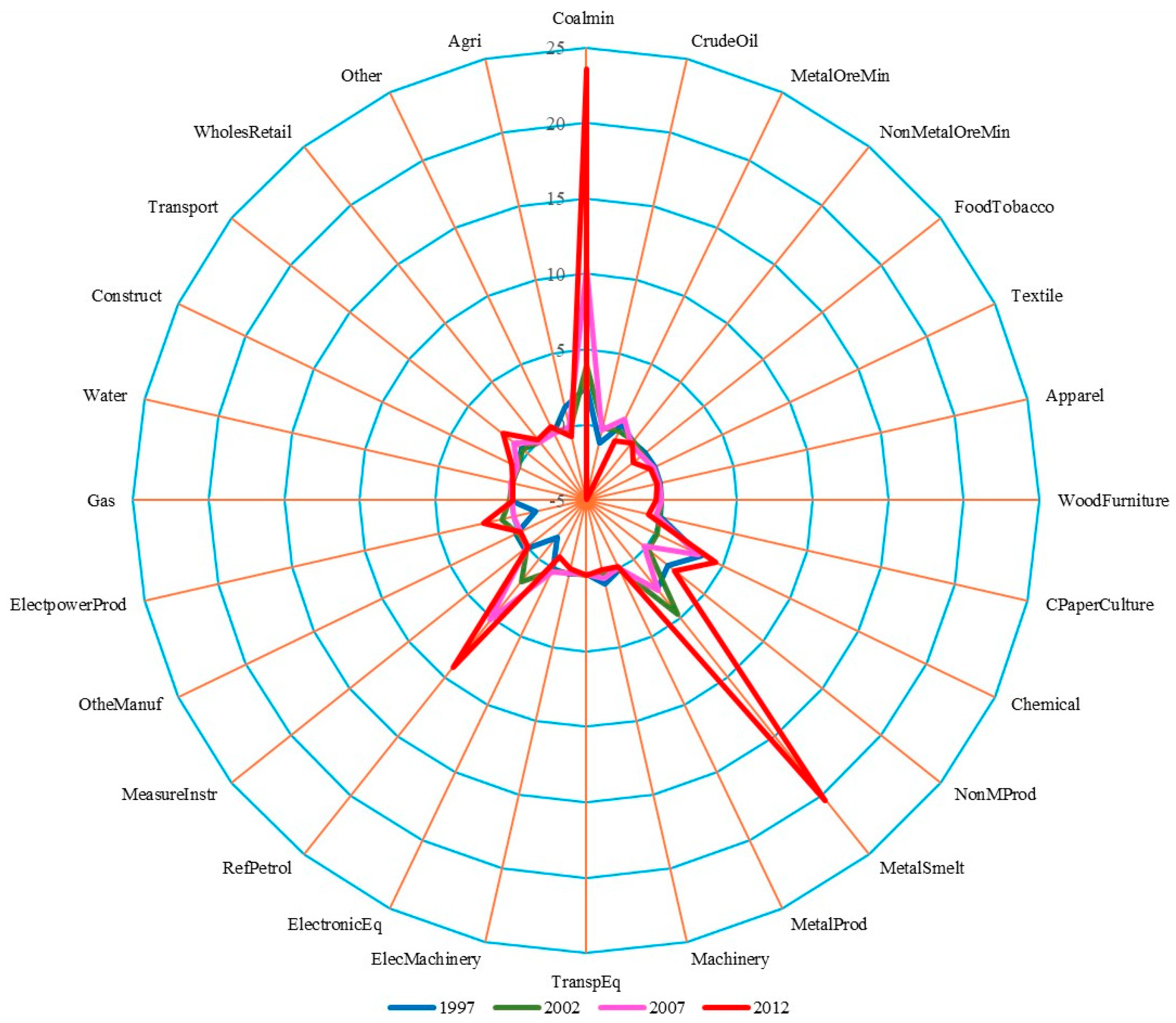
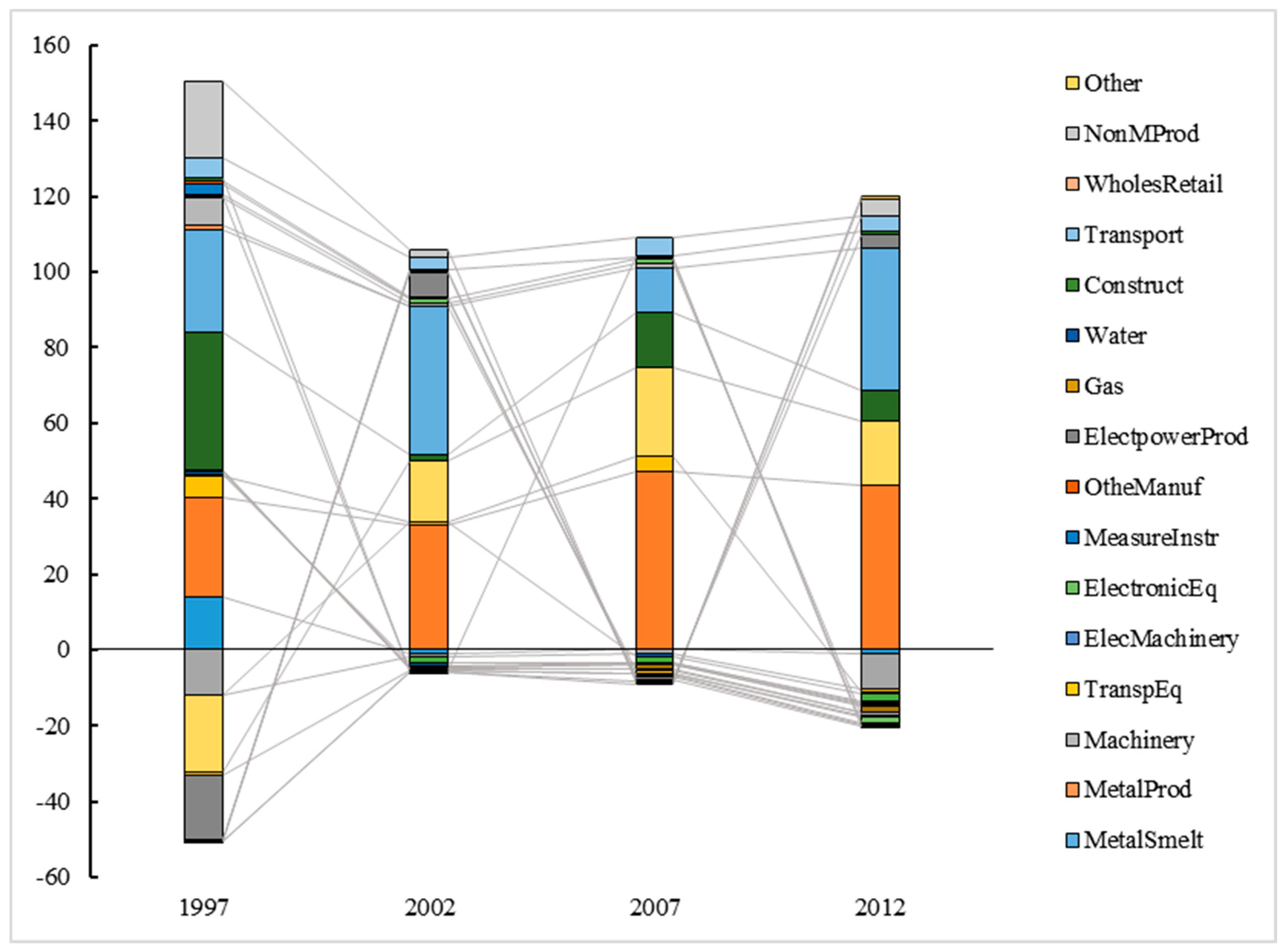
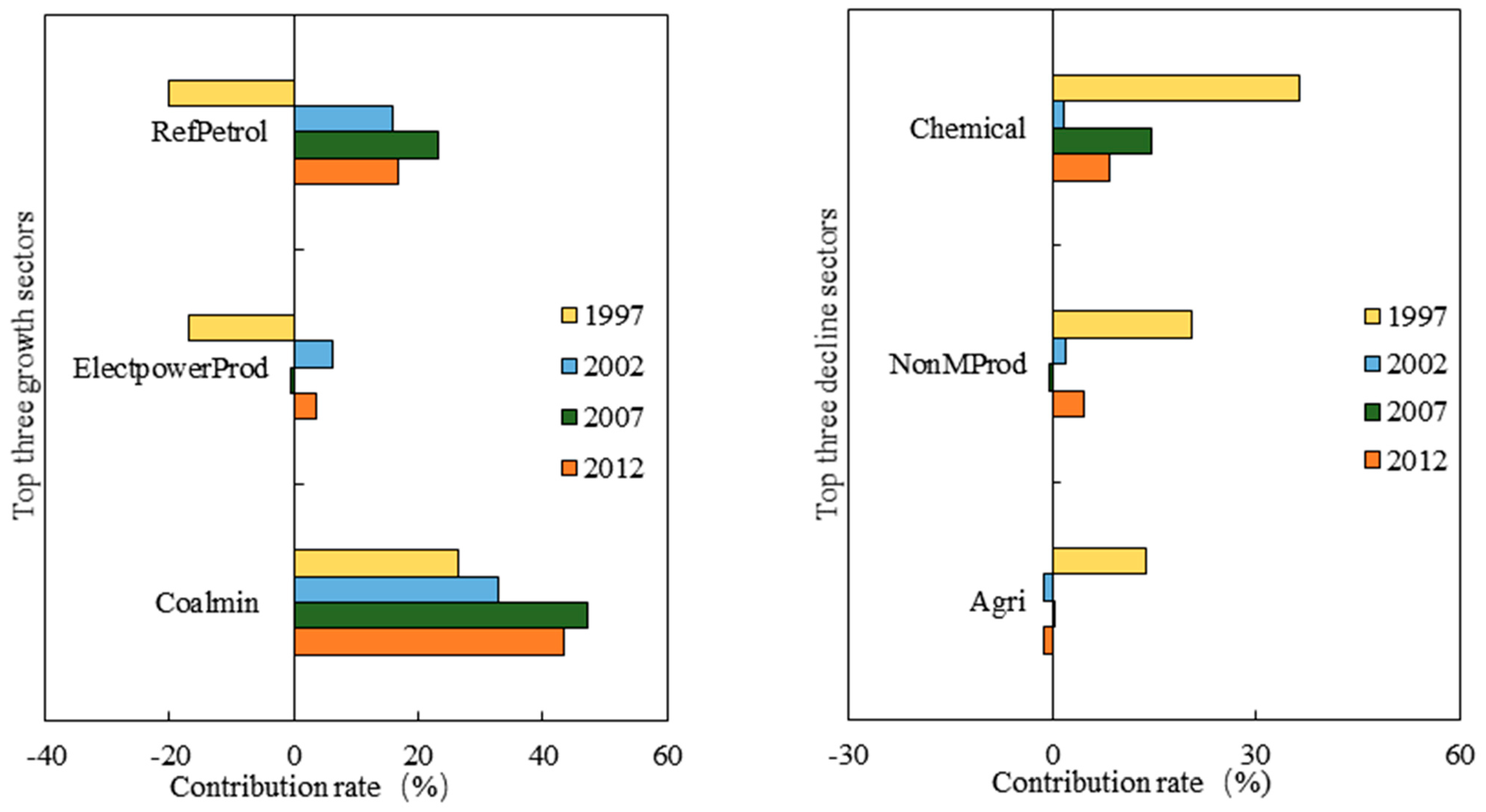
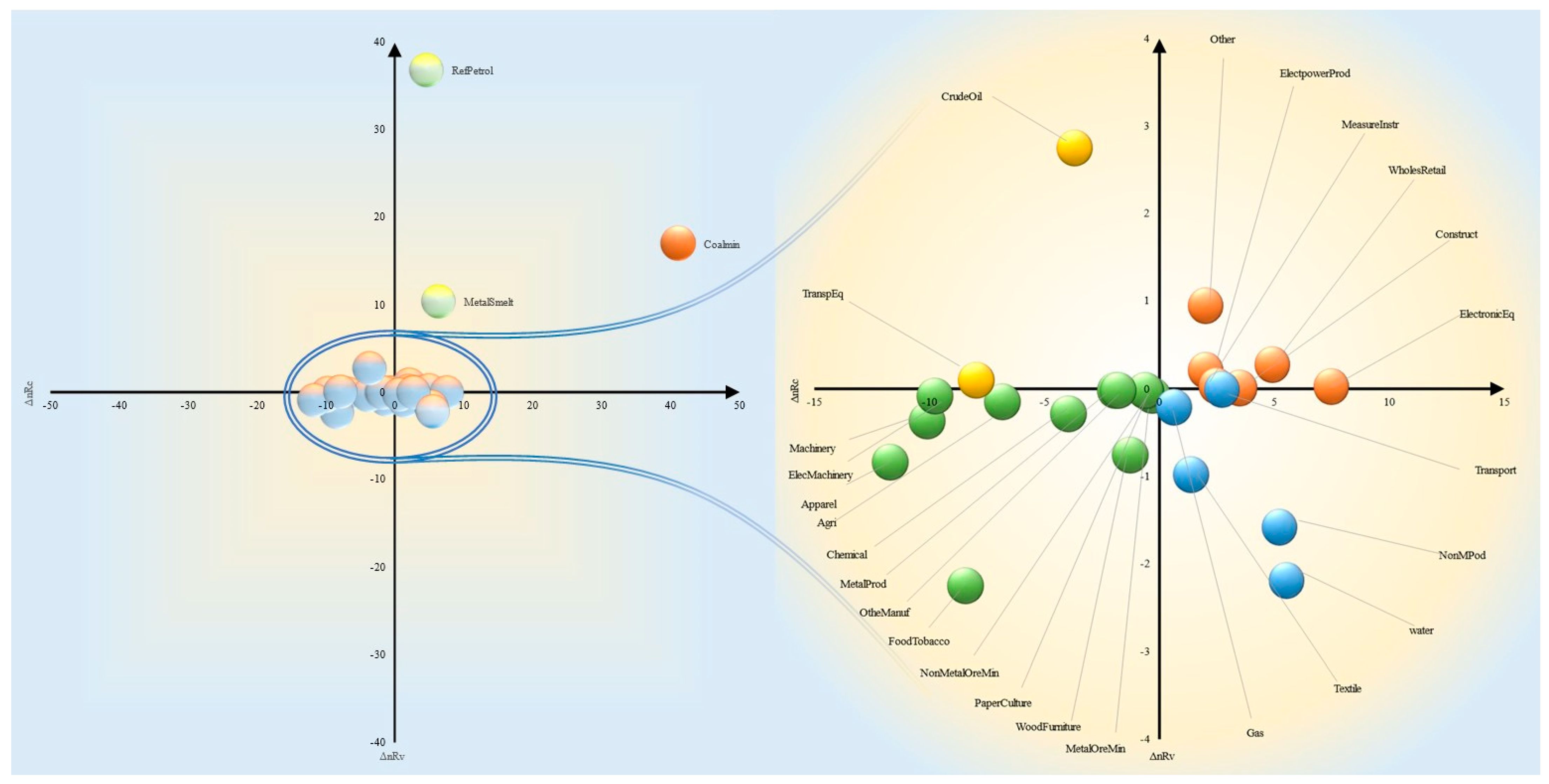
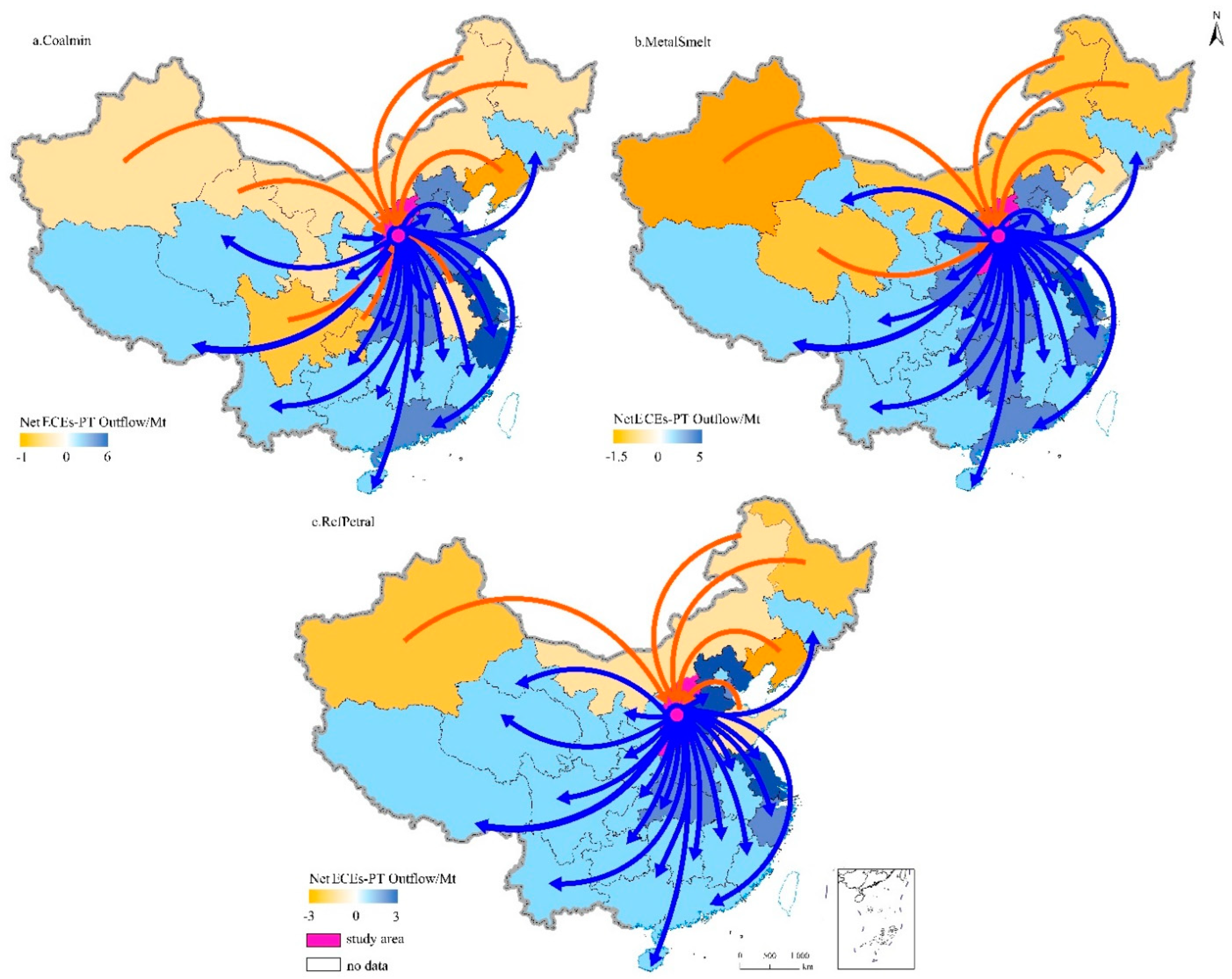
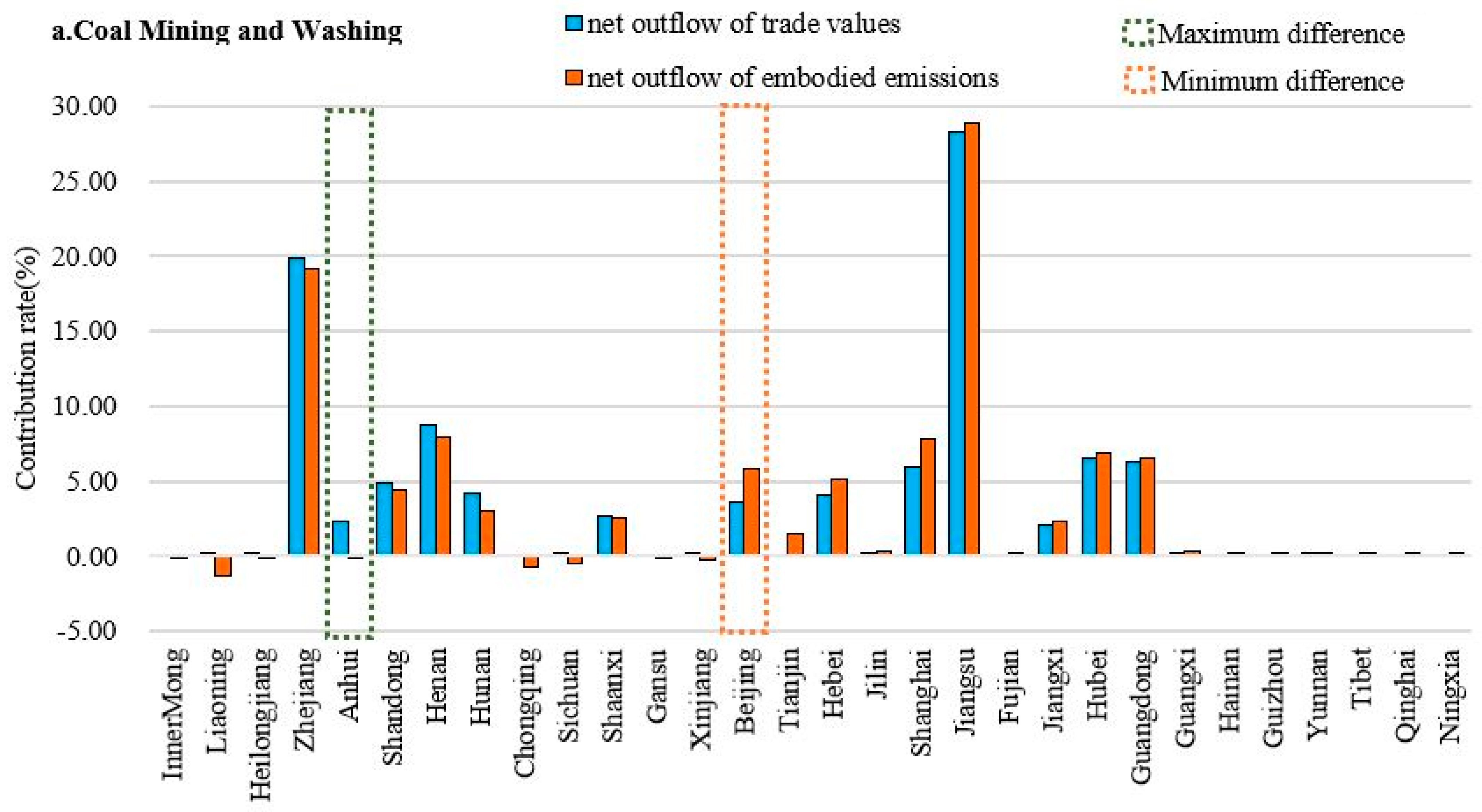

| Sectors | Technology | Structure | Volume |
|---|---|---|---|
| Agri | −0.96 | −0.86 | −0.13 |
| Coalmin | 10.12 | 5.77 | 5.20 |
| CrudeOil | −1.81 | −0.90 | −1.09 |
| MetalOreMin | −0.57 | −0.47 | −0.13 |
| NonMetalOreMin | −0.06 | −0.03 | −0.03 |
| FoodTobacco | −0.49 | −0.31 | −0.21 |
| Textile | −0.15 | −0.10 | −0.05 |
| Apparel | −0.09 | −0.05 | −0.04 |
| WoodFurniture | −0.18 | −0.11 | −0.08 |
| PaperCulture | −0.39 | −0.25 | −0.17 |
| RefPetrol | 5.35 | 3.70 | 1.98 |
| Chemical | 0.45 | −0.41 | 1.03 |
| NonMProd | 0.24 | −0.24 | 0.57 |
| MetalSmelt | 8.55 | 4.78 | 4.50 |
| MetalProd | −0.11 | −0.09 | −0.03 |
| Machinery | −0.50 | −0.45 | −0.06 |
| TranspEq | 0.03 | 0.04 | −0.01 |
| ElecMachinery | −0.17 | −0.11 | −0.07 |
| ElectronicEq | −0.44 | −0.28 | −0.19 |
| MeasureInstr | −0.15 | −0.14 | −0.01 |
| OtheManuf | −0.14 | −0.11 | −0.04 |
| ElectpowerProd | 1.74 | 1.40 | 0.41 |
| Gas | −0.07 | −0.04 | −0.03 |
| Water | −0.01 | 0.00 | −0.01 |
| Construct | 0.19 | 0.10 | 0.10 |
| Transport | 0.75 | 0.37 | 0.46 |
| WholesRetail | 0.06 | 0.04 | 0.02 |
| Other | 0.20 | 0.13 | 0.08 |
| Agri | −0.96 | −0.86 | −0.13 |
| Coalmin | 10.12 | 5.77 | 5.20 |
| CrudeOil | −1.81 | −0.90 | −1.09 |
| MetalOreMin | −0.57 | −0.47 | −0.13 |
| Type | Optimization Measures | |
|---|---|---|
| Type A | Promoted type | Expand investment, scale up production, and expand market share |
| Type B | Controlled type | Decrease investment, scale down production, and decrease market share |
| Type C | C1: Orientation-encouraged type | Moderately expand investment, extend trade with lower industrial advantage provinces |
| C2: Orientation-reduced type | Expand trade with lower advantage industrial provinces and decrease trade with greater industrial advantage provinces | |
| Type D | Regulated type | Cut down investment, control production scale, combining market regulation and government control |
Publisher’s Note: MDPI stays neutral with regard to jurisdictional claims in published maps and institutional affiliations. |
© 2022 by the authors. Licensee MDPI, Basel, Switzerland. This article is an open access article distributed under the terms and conditions of the Creative Commons Attribution (CC BY) license (https://creativecommons.org/licenses/by/4.0/).
Share and Cite
Liu, Q.; Dong, S.; Li, F.; Cheng, H.; Li, S.; Yang, Y. Features, Mechanisms and Optimization of Embodied Carbon Emissions for Energy Supply Bases: Case Study of Shanxi, China. Energies 2022, 15, 2079. https://doi.org/10.3390/en15062079
Liu Q, Dong S, Li F, Cheng H, Li S, Yang Y. Features, Mechanisms and Optimization of Embodied Carbon Emissions for Energy Supply Bases: Case Study of Shanxi, China. Energies. 2022; 15(6):2079. https://doi.org/10.3390/en15062079
Chicago/Turabian StyleLiu, Qian, Suocheng Dong, Fujia Li, Hao Cheng, Shantong Li, and Yang Yang. 2022. "Features, Mechanisms and Optimization of Embodied Carbon Emissions for Energy Supply Bases: Case Study of Shanxi, China" Energies 15, no. 6: 2079. https://doi.org/10.3390/en15062079
APA StyleLiu, Q., Dong, S., Li, F., Cheng, H., Li, S., & Yang, Y. (2022). Features, Mechanisms and Optimization of Embodied Carbon Emissions for Energy Supply Bases: Case Study of Shanxi, China. Energies, 15(6), 2079. https://doi.org/10.3390/en15062079







